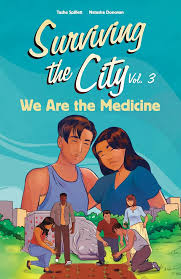Surviving the City Vol. 3 We Are the Medicine

Surviving the City Vol. 3 We Are the Medicine
People can’t carry this heartache in isolation.
People need to know that horrible things can’t just happen and get swept under the rug.
Each of those children had a name, family, and future. Each one mattered.
We Are the Medicine is the third and final installment of Tasha Spillett and Natasha Donovan’s Surviving the City graphic novel series for teens. This time around, best friends Dez – Inninew (Cree) and Miikwan – Anishnaabe (Ojibway) must come to terms with the horrors of residential schools.
Coming out of the COVID-19 pandemic, Dez and Miikwan, along with their respective partners Kacey and Riel, are in their final year of high school. As they are discussing their future plans – university for Miikwan and Riel and a cool job for Dez – news breaks about a mass grave being discovered with the remains of 215 children found buried at a former British Columbia residential school.
Reeling from this news, the group of teens is having a hard time coming to grips with the discovery. Riel, in particular, is finding it hard to process his anger. While discussing the news with residential school survivor and elder Geraldine, Riel gets visibly upset. Seeing that Riel is in real pain, Geraldine encourages Riel to process his feelings in a constructive and healthy manner.
After offering tobacco to his ancestors, Riel comes up with an idea – to hold a powwow that honours the children, brings the community together, and finally brings healing to all. With the help of his friends and cousin Ginebig, an Afro-Indigenous teen from the Rez, the powwow is held in front of the Manitoban Legislative Assembly.
Coinciding with real events that took place there on July 1, 2021, Riel and his cousin Ginebig take part in a protest that topples a statue of Queen Victoria. As both boys are coming to terms with colonialism and its traumas, they must then contend with racial profiling and police brutality.
But in the end, the story ends on a hopeful note. The group of teens realizes that hate will do more harm than good, and that, if they want things to change, they have to start by planting seeds of hope. They realize that they are the medicine and they will heal each other.
A truly poignant YA graphic novel, We Are the Medicine deals with some very heavy issues, from colonialism and residential schools to intergenerational trauma and police brutality. But, at its core, the story is one of hope. It gives young readers the courage and confidence to stand up for what they believe in and to fight for a more just future.
Spillett and Donovan are a great duo, telling a story that needs to be told. Complementing Spillett’s formidable story telling prowess are Donovan’s vivid illustrations that bring depth and emotion to the story. Her use of spectral children throughout the graphic novel is truly moving and will literally give the reader goosebumps.
Overall, We Are the Medicine is a very timely and moving YA graphic novel.
Teresa Iaizzo is a librarian with the Toronto Public Library.
